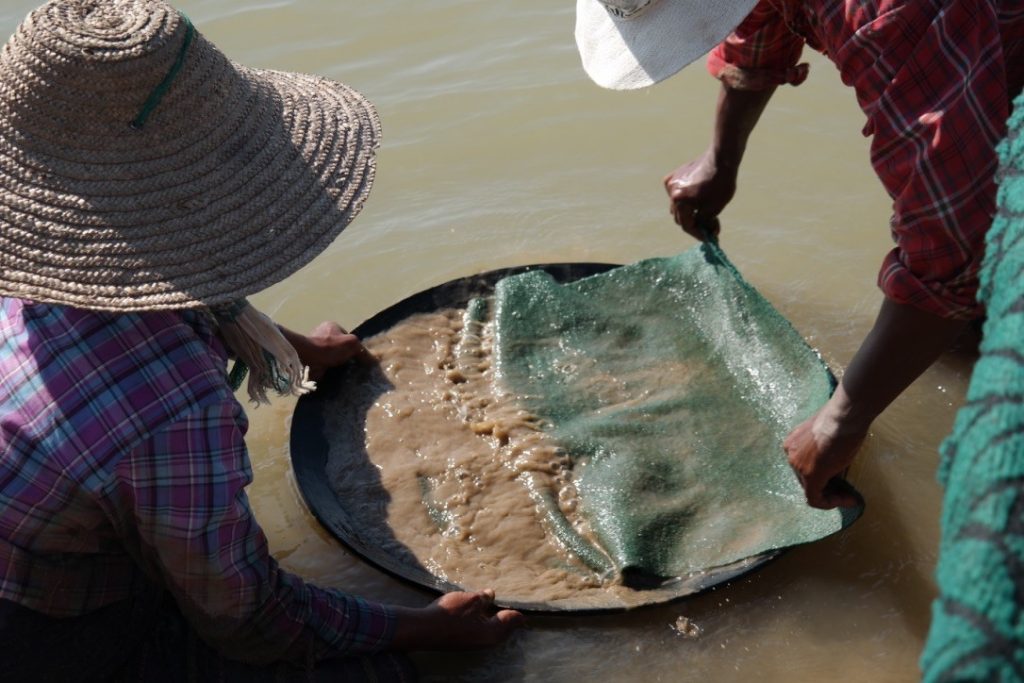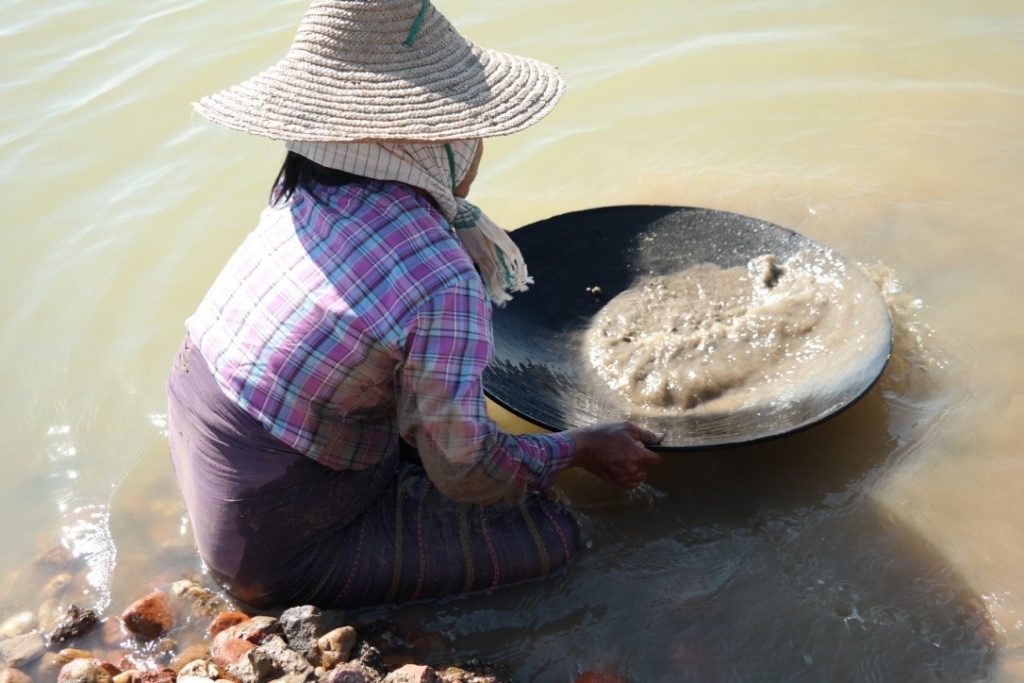

The diamond is a superlative: it is the hardest known mineral, has the highest refraction of light and is a symbol of eternity. In mythology, the diamond was regarded as liberating from demonic influences and represented justice and virtue. The diamond appears in different cuts, such as pear cut, scissor cut, oval cut or heart cut. The best-known cut is undoubtedly the brilliant cut.
Color: colorless, yellow, brown, black, bluish, greenish, reddish. Where found: mainly in Africa and Siberia.
The quality of diamonds is assessed according to the „4 Cs“: color, clarity, cut and carat (weight).
The ruby owes its name to its red color, Latin „rubeus“. In Sanskrit, the ruby is called „ratnarai“, which means „king of gemstones“. It is one of the most valuable stones. The most beautiful color of the ruby is called „pigeon’s blood red“. In the ancient cultures of Europe and India, the ruby was unanimously regarded as the stone of the sun. It represented vitality, inner fire, love and passion. It was said to darken when disaster was approaching. Where it was found: Myanmar, Thailand, Sri Lanka and Tanzania.
„Sapphire“ comes from the Greek („sáppheiros“) – the meaning is unclear. The sapphire is one of the most popular jewels. It is particularly popular in the so-called cornflower blue. However, the orange to yellow-colored padparadscha sapphire is also very popular. Its name comes from the Sinhalese and means „lotus blossom“. The most beautiful orange-colored stones are found in Sri Lanka. Sapphire (from the Sanskrit „sani“ [=Saturn]) was regarded as the stone of Saturn in the ancient cultures of Europe and India. It represents the sky, magic, loyalty and friendship. Color: blue, colorless, pink, pink, orange, yellow, green, violet, black. Main places of discovery: Sri Lanka, Thailand, Myanmar.
„Emerald“ was borrowed from the Greek „smaragdos“ and means green stone. Most emeralds are interspersed with inclusions. Clear stones in a strong, rich green are rare; they are often valued more highly than diamonds. In the ancient cultures of Europe and India, the emerald was associated with Mercury, the messenger of the gods and god of paths, sleep and dreams, and was therefore regarded as a stone of divine inspiration. Color: green. Most important place of discovery: South America (Colombia).
The name is based on the Latin „aqua marina“ („water of the sea“) because of its seawater color. The most sought-after is the deep blue aquamarine, also known as „Santa Maria“. After the mine of the same name in Brazil. According to ancient traditions, it is the stone of seers, mystics and healers. Aquamarine brings light and clarity to the hidden corners of the soul. Color: dark blue, light blue, blue-green. Most important places where it is found: Brazil and Madagascar.
The name beryl has its roots in the Greek „bḗryllos“ – the meaning is not entirely clear. The colorless beryl was used to make eyeglasses in ancient times. Since ancient times, beryl has been regarded as a detoxifying, eye-strengthening crystal. Color: golden yellow, yellow-green, yellow, pink, colorless.
The name means „the grainy one“ and is derived from the Latin word „granum“. Garnet comes in many different colors. The color red is the most common. In common parlance, garnet is understood to mean red almandine and pyrope, formerly also known as carbuncle. However, there are also many other garnets, such as rhodolite (red) or mandarin spessartine; it is often called mandarin garnet and is orange to reddish brown. Garnet is regarded as a stone that brightens the soul and brings light and hope. Color: green, yellow, orange, red, brown. Where it is found: Garnet has been and is found on almost every continent. Mainly in the USA and Africa.
No gemstone displays such a wealth of color as tourmaline. Although it has been known since ancient times, it was only brought to Europe from Ceylon by the Dutch in 1703. It is a symbol of wisdom. It is said to strengthen friendships. According to Arabic tradition, tourmaline is a stone of the sun, which strengthens the heart and protects against nightmares. Color: colorless, pink, red, yellow, brown, green, blue, violet, black, multicolored. All rainbow colors. Rubelite: Rubelite is a very high-quality variety of tourmaline. The color spectrum ranges from pink to bright red. Locations: Tourmalines are found almost everywhere in the world. The most important deposits are in Brazil, Sri Lanka and Southwest Africa.
Tanzanite was named after its place of discovery, the state of Tanzania. It was discovered in 1967. The color is ultramarine to sapphire blue in good quality. In artificial light it shows more of its violet color. It stands out due to its occasional two-tone color.
Its name is based on the Greek „améthystos“, which means „to counteract intoxication“. The amethyst was considered an amulet against drunkenness. It is said to have supernatural powers. It is a lucky charm, gives stability, protects against sorcery and homesickness. Color: violet, blue-red-violet. Where found: Brazil, Madagascar, Southwest Africa, South America, Sri Lanka and the USA.
Its shimmer, which is reminiscent of moonlight, gave it its name. The bluish-white shimmer glides over its entire surface when it is moved. It was once believed that the waxing and waning phases of the moon could be seen in moonstone. It was used in Europe as well as in the Far East and the Orient as a lucky stone and for love charms. Color: colorless, white, brownish, greenish, reddish or bluish with a light or bluish shimmer. Main places of discovery: Sri Lanka and India.
The origin of the pearl was shrouded in legend for a long time. It was thought that the oyster was fertilized by raindrops or dew. The pearl is a jewel of nature. Pearls are the product of shells. They have a symbolic character in many cultures. In China, for example, pearls are a symbol of wealth, wisdom and dignity, in Japan they signify good luck and in India they symbolize a wealth of children. The pearl was also regarded as an aphrodisiac and a cure for melancholy and madness. It is also a symbol for tears. The Indian heroic epic Mahabharata, the Old Testament, the Talmud and the Koran praise the pearl for its ideal beauty and perfect purity. In the Middle Ages, it acquired a sacred character. It was regarded as a symbol of love for God. In China, pearl mussels were fished in rivers and on the southern coast many thousands of years before Christ. Until the beginning of the 20th century, there were pearl divers. Wrapped in linen cloths, their noses closed with a clasp, they jumped into the water on the open sea and sank to the seabed with a weight. To this day, the Chinese are leaders in the cultivation of freshwater pearls. But they did not succeed in cultivating full-round pearls. This is where the Japanese began at the beginning of the last century. The full-round Akoya pearl was created from the Akoya oyster. It is still very popular today.
Only naturally formed pearls, i.e. pearls that have not been cultivated, may be referred to as genuine pearls or natural pearls. They are also occasionally referred to as oriental pearls.
Cultured pearls grown in the sea from the Sea of Japan. As a rule, the Akoya cultured pearl is two to nine millimetres in size.
The South Sea cultured pearl measures between 10 and 20 millimetres, sometimes it is even larger. Its mother-of-pearl layer is thicker than that of the Akoya pearl. It is also known as the queen of cultured pearls.
A pearl obtained from the black-lipped pearl oyster in French Polynesia. Its color varies between anthracite and black.
They are cultivated in lakes or small rivers. In contrast to seawater pearls, they usually do not have an implanted mother-of-pearl core. Most freshwater cultured pearls come from China.
Irregularly shaped beads.
Half beads in atypical shapes such as hemispheres, hearts and squares.
Luster is the most important criterion when evaluating a pearl. This technical term refers to the reflection of light that refracts off the many layers of aragonite in the mother-of-pearl and creates a shine that appears to come from within the pearl. Light reflection and luster should be as powerful and deep as possible, which speaks for a thick mother-of-pearl layer. The more intense the luster of a pearl, the more valuable it is.
Note: The mandatory field is marked. All other fields are voluntary. Your data will only be collected and stored electronically strictly for the purpose of processing and answering your request. Information on data processing can be found here: Privacy Policy.
We use cookies on our website. Some of them are essential, while others help us to improve this website and your experience. If you are under the age of 16 and wish to give your consent to volunteer services, you must ask your parent or guardian for permission. We use cookies and other technologies on our website. Some of them are essential, while others help us to improve this website and your experience. Personal data may be processed (e.g. IP addresses), e.g. for personalized ads and content or ad and content measurement. You can find more information about the use of your data in our privacy policy. You can revoke or adjust your selection at any time under Settings.
If you are under the age of 16 and wish to give your consent to volunteer services, you must ask your parent or guardian for permission. We use cookies and other technologies on our website. Some of them are essential, while others help us to improve this website and your experience. Personal data may be processed (e.g. IP addresses), e.g. for personalized ads and content or ad and content measurement. You can find more information about the use of your data in our privacy policy. Here you will find an overview of all cookies used. You can give your consent to entire categories or have further information displayed and thus select only certain cookies.